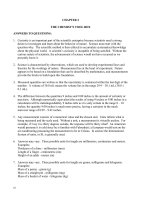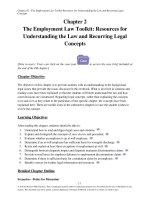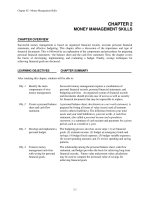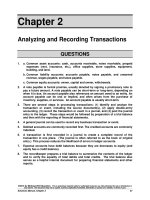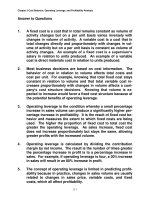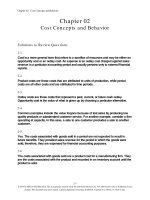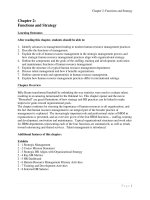Test bank and solution manual for ch02 cost concepts and behavior (1)
Bạn đang xem bản rút gọn của tài liệu. Xem và tải ngay bản đầy đủ của tài liệu tại đây (1.15 MB, 49 trang )
Chapter 02 - Cost Concepts and Behavior
Chapter 02
Cost Concepts and Behavior
Solutions to Review Questions
2-1.
Cost is a more general term that refers to a sacrifice of resources and may be either an
opportunity cost or an outlay cost. An expense is an outlay cost charged against sales
revenue in a particular accounting period and usually pertains only to external financial
reports.
2-2.
Product costs are those costs that are attributed to units of production, while period
costs are all other costs and are attributed to time periods.
2-3.
Outlay costs are those costs that represent a past, current, or future cash outlay.
Opportunity cost is the value of what is given up by choosing a particular alternative.
2-4.
Common examples include the value forgone because of lost sales by producing low
quality products or substandard customer service. For another example, consider a firm
operating at capacity. In this case, a sale to one customer precludes a sale to another
customer.
2-5.
Yes. The costs associated with goods sold in a period are not expected to result in
future benefits. They provided sales revenue for the period in which the goods were
sold; therefore, they are expensed for financial accounting purposes.
2-6.
The costs associated with goods sold are a product cost for a manufacturing firm. They
are the costs associated with the product and recorded in an inventory account until the
product is sold.
2-1
© 2014 by McGraw-Hill Education. This is proprietary material solely for authorized instructor use. Not authorized for sale or distribution in any
manner. This document may not be copied, scanned, duplicated, forwarded, distributed, or posted on a website, in whole or part.
Chapter 02 - Cost Concepts and Behavior
2-7.
Both accounts represent the cost of the goods acquired from an outside supplier, which
include all costs necessary to ready the goods for sale (in merchandising) or production
(in manufacturing).
The merchandiser expenses these costs as the product is sold, as no additional costs
are incurred. The manufacturer transforms the purchased materials into finished goods
and charges these costs, along with conversion costs to production (work in process
inventory). These costs are expensed when the finished goods are sold.
2-8.
Direct materials: Materials in their raw or unconverted form, which become an integral
part of the finished product are considered direct materials. In some
cases, materials are so immaterial in amount that they are considered
part of overhead.
Direct labor:
Costs associated with labor engaged in manufacturing activities.
Sometimes this is considered as the labor that is actually responsible for
converting the materials into finished product. Assembly workers,
cutters, finishers and similar “hands on” personnel are classified as
direct labor.
Manufacturing All other costs directly related to product manufacture. These costs
overhead:
include the indirect labor and materials, costs related to the facilities and
equipment required to carry out manufacturing operations, supervisory
costs, and all other support activities.
2-9.
Gross margin is the difference between revenue (sales) and cost of goods sold.
Contribution margin is the difference between revenue (sales) and variable cost.
2-10.
Contribution margin is likely to be more important, because it reflects better how profits
will change with decisions.
2-11.
Step costs change with volume in steps, such as when supervisors are added.
Semivariable or mixed costs have elements of both fixed and variable costs. Utilities
and maintenance are often mixed costs.
2-2
© 2014 by McGraw-Hill Education. This is proprietary material solely for authorized instructor use. Not authorized for sale or distribution in any
manner. This document may not be copied, scanned, duplicated, forwarded, distributed, or posted on a website, in whole or part.
Chapter 02 - Cost Concepts and Behavior
2-12.
Total variable costs change in direct proportion to a change in volume (within the
relevant range of activity). Total fixed costs do not change as volume changes (within
the relevant range of activity).
Solutions to Critical Analysis and Discussion Questions
2-13.
The statement is not true. Materials can be direct or indirect. Indirect materials include
items such as lubricating oil, gloves, paper supplies, and so on. Similarly, indirect labor
includes plant supervision, maintenance workers, and others not directly associated
with the production of the product.
2-14.
No. Statements such as this almost always refer to the full cost per unit, which includes
fixed and variable costs. Therefore, multiplying the cost per seat-mile by the number of
miles is unlikely to give a useful estimate of flying one passenger. We should multiply
the variable cost per mile by 1,980 miles to estimate the costs of flying a passenger
from Detroit to Los Angeles.
2-15.
Marketing and administrative costs are treated as period costs and expensed for
financial accounting purposes in both manufacturing and merchandising organizations.
However, for decision making or assessing product profitability, marketing and
administrative costs that can be reasonably associated with the product (productspecific advertising, for example) are just as important as the manufacturing costs.
2-16.
There is no “correct” answer to this allocation problem. Common allocation procedures
would include: (1) splitting the costs equally (25% each), (2) dividing the costs by the
miles driven and charging based on the miles each person rides, (3) charging the
incremental costs of the passengers (almost nothing), assuming you were going to drive
to Texas anyway.
2-17.
The costs will not change. Your allocation in 2-16 was not “incorrect,” because the
purpose of the allocation is not to determine incremental costs.
2-18.
Answers will vary. The major cost categories include servers (mostly fixed), personnel
(mostly fixed), and licensing costs (mostly variable).
2-3
© 2014 by McGraw-Hill Education. This is proprietary material solely for authorized instructor use. Not authorized for sale or distribution in any
manner. This document may not be copied, scanned, duplicated, forwarded, distributed, or posted on a website, in whole or part.
Chapter 02 - Cost Concepts and Behavior
2-19.
Direct material costs include the cost of supplies and medicine. One possible direct
labor cost would be nursing staff assigned to the unit. Indirect costs include the costs of
hospital administration, depreciation on the building, security costs, and so on.
2-20.
Answers will vary. Common suggestions are number of students in each program,
usage (cafeteria: meals; library: study rooms reserved; or career placement: interviews,
for example), assuming usage is measured, or revenue (tuition dollars).
2-21.
No, R&D costs are relevant for many decisions. For example, should a program of
research be continued? Was a previous R&D project profitable? Should we change our
process of approving R&D projects? R&D costs are expensed (currently) for financial
reporting, but for managerial decision-making the accounting treatment is not relevant.
Solutions to Exercises
2-22. (15 min.) Basic Concepts.
a.
b.
c.
False. The statement refers to an expense. For example, R&D costs are incurred
in expectation of future benefits.
True. Each unit of a product has the same amount of direct material (same cost
per unit), but producing more units requires more material (and more cost).
False. Variable costs can be direct (direct materials) or indirect (lubricating oil for
machines that produce multiple products.)
2-23. (15 min.) Basic Concepts.
Fixed (F)
Period (P)
Variable (V) Product (M)
Cost Item
a.
b.
c.
Depreciation on buildings for administrative staff offices......
Bonuses of top executives in the company ..........................
Overtime pay for assembly workers .....................................
F
F
V
P
P
M
2-4
© 2014 by McGraw-Hill Education. This is proprietary material solely for authorized instructor use. Not authorized for sale or distribution in any
manner. This document may not be copied, scanned, duplicated, forwarded, distributed, or posted on a website, in whole or part.
Chapter 02 - Cost Concepts and Behavior
d.
e.
f.
g.
h.
i.
j.
Transportation-in costs on materials purchased ..................
Assembly line workers’ wages .............................................
Sales commissions for sales personnel ...............................
Administrative support for sales supervisors ........................
Controller’s office rental .......................................................
Cafeteria costs for the factory ..............................................
Energy to run machines producing units of output in the
factory….............. .................................................................
V
V
V
F
F
F
M
M
P
P
P
M
V
M
2-24. (10 min.) Basic Concepts.
a. Property taxes on the factory. ......................................................................
b. Direct materials used in production process. ...............................................
c. Transportation-in costs on materials purchased. .........................................
d. Lubricating oil for plant machines. ...............................................................
e. Assembly line worker’s salary. .....................................................................
C
P
P
C
B
2-25. (15 min.) Basic Concepts.
9
6
10
2
11
8
5
3
1
4
7
Concept
Definition
Period cost ........................Cost that can more easily be attributed to
time intervals.
Indirect cost .......................Cost that cannot be directly related to a
cost object.
Fixed cost ..........................Cost that does not vary with the volume of
activity.
Opportunity cost ................Lost benefit from the best forgone
alternative.
Outlay cost ........................Past, present, or near-future cash flow.
Direct cost .........................Cost that can be directly related to a cost
object.
Expense ............................Cost charged against revenue in a
particular accounting period.
Cost ...................................Sacrifice of resources.
Variable cost .....................Cost that varies with the volume of activity.
Full absorption cost ...........Cost used to compute inventory value
according to GAAP.
Product cost ......................Cost that is part of inventory.
2-5
© 2014 by McGraw-Hill Education. This is proprietary material solely for authorized instructor use. Not authorized for sale or distribution in any
manner. This document may not be copied, scanned, duplicated, forwarded, distributed, or posted on a website, in whole or part.
Chapter 02 - Cost Concepts and Behavior
2-26. (15 min.) Basic Concepts.
Fixed (F)
Period (P)
Variable (V) Product (M)
Cost Item
a. Depreciation on pollution control equipment in the plant ..
b. Chief financial officer’s salary...........................................
c. Power to operate factory equipment ................................
d. Commissions paid to sales personnel ..............................
e. Office supplies for the human resources manager ...........
F
F
V
V
F
M
P
M
P
P
2-27. (15 min.) Basic Concepts.
a.
b.
c.
d.
e.
f.
g.
h.
i.
Variable production cost per unit: ($240 + $40 + $10 + $20) .......................
$310
Variable cost per unit: ($310 + $30) .............................................................
$340
Full cost per unit: [$340 + ($100,000 ÷ 1,000 units)] ....................................
$440
Full absorption cost per unit: [$310 + ($60,000 ÷ 1,000)] .............................
$370
Prime cost per unit. (materials + labor + outsource) ....................................
$290
Conversion cost per unit: (labor + overhead + outsource) ...........................
$360
Contribution margin per unit: ($600 – $340)...............................................
$260
Gross margin per unit: ($600 – full absorption cost of $370).......................
$230
Suppose the number of units decreases to 800 units per month,
c, d, f
which is within the relevant range. Which parts of (a) through (h) will
and h
change? For each amount that will change, give the new amount
will
for a volume of 800 units.
change,
as
follows
c. Full cost = $340 + ($100,000 ÷ 800) = $465
d. Full absorption cost = $310 + ($60,000 ÷ 800) = $385
f. Conversion costs = $240 + $20 + ($60,000 ÷ 800) + $40 = $375
h. Gross margin = $600 – $385 = $215
2-28. (15 min.) Basic Concepts: Terracotta, Inc.
a.
b.
c.
d.
e.
f.
g.
Prime cost per unit: (materials + labor) ........................................................$10
Contribution margin per unit: ($25 – $18) ..................................................$7
Gross margin per unit: ($25 – full absorption cost of $18.50) .....................
$6.50
Conversion cost per unit: (labor + overhead) ...............................................
$12.50
Variable cost per unit: ($15 + $3) .................................................................$18
Full absorption cost per unit: [$15 + ($1,050,000 ÷ 300,000)] ......................
$18.50
Variable production cost per unit: ($4 + $6 + $5) .........................................$15
2-6
© 2014 by McGraw-Hill Education. This is proprietary material solely for authorized instructor use. Not authorized for sale or distribution in any
manner. This document may not be copied, scanned, duplicated, forwarded, distributed, or posted on a website, in whole or part.
Chapter 02 - Cost Concepts and Behavior
h.
i.
Full cost per unit. [$18 + ($1,350,000 ÷ 300,000 units)] ...............................
$22.50
Suppose the number of units increases to 400,000 units per month,
c, d, f
which is within the relevant range. Which parts of (a) through (h) will
and h
change? For each amount that will change, give the new amount
will
for a volume of 400,000 units.
change,
as
follows
c. Gross margin = $25.00 – $17.63 = $7.37
d. Conversion costs = $4 + $5 + ($1,050,000 ÷ 400,000) = $11.63
f. Full absorption cost = $15 + ($1,050,000 ÷ 400,000) = $17.63
h. Full cost = $18 + ($1,350,000 ÷ 400,000) = $21.38
2-29. (15 min.) Cost Allocation—Ethical Issues
This problem is based on the experience of the authors’ research at several companies.
a. Answers will vary as there are several defensible bases on which to allocate the
product development costs. As an example, many government-purchasing contracts
are based on the cost of the product or service. In this case, using expected sales
(units or revenue) leads to a potential circularity. Price depends on cost, which
depends on sales, which depends on price.
b. The company has an incentive to allocate as much cost as possible to government
sales. This cost will be reimbursed (and the government may be less pricesensitive). Of course, the government recognizes this and has detailed allocation
guidelines in place and an agency (the Defense Contract Audit Agency) that
monitors contracts and the allocation of costs.
2-30. (15 min.) Cost Allocation—Ethical Issues
This problem is based on the experience of the authors’ research at several companies.
a. Answers will vary as there are several defensible bases on which to allocate the
common costs. One possibility is relative sales revenue. (We ignore here whether
we should allocate these costs, something we discuss in chapter 4.)
b. You should explain to Star that you cannot agree with the allocation basis, especially
given the reason for selecting the basis. If this fails to persuade Star, you should
disclose to Star’s boss your disagreement with the analysis and the relation between
Star and the vendor.
2-7
© 2014 by McGraw-Hill Education. This is proprietary material solely for authorized instructor use. Not authorized for sale or distribution in any
manner. This document may not be copied, scanned, duplicated, forwarded, distributed, or posted on a website, in whole or part.
Chapter 02 - Cost Concepts and Behavior
2-31. (30 min.) Prepare Statements for a Manufacturing Company: Hill
Components.
Hill Components
Cost of Goods Sold Statement
For the Year Ended December 31
Beginning work in process inventory ..............
Manufacturing costs:
Direct materials:
Beginning inventory ................................ $48,100
Purchases ............................................... 55,900 (a)*
Materials available ............................... $104,000
Less ending inventory ............................. 44,200
Direct materials used ...........................
$59,800
Other manufacturing costs ......................
15,470 **
Total manufacturing costs ...................
Total costs of work in process .................
Less ending work in process ...............
Cost of goods manufactured ............
Beginning finished goods inventory................
Finished goods available for sale ...................
Ending finished goods inventory ....................
Cost of goods sold .........................................
$67,730
75,270 (c)
$143,000
71,500
$ 71,500 (b)
15,600
$ 87,100
18,200
$68,900
* Letters (a), (b), and (c) refer to amounts found in solutions to requirements a, b, and c.
** Difference between total manufacturing costs of $75,270 and direct materials used of
$59,800.
2-8
© 2014 by McGraw-Hill Education. This is proprietary material solely for authorized instructor use. Not authorized for sale or distribution in any
manner. This document may not be copied, scanned, duplicated, forwarded, distributed, or posted on a website, in whole or part.
Chapter 02 - Cost Concepts and Behavior
2-32. (10 min.) Prepare Statements for a Service Company: Chuck’s Brokerage
Service.
2-33. Prepare Statements for a Service Company: Where2 Services.
2-9
© 2014 by McGraw-Hill Education. This is proprietary material solely for authorized instructor use. Not authorized for sale or distribution in any
manner. This document may not be copied, scanned, duplicated, forwarded, distributed, or posted on a website, in whole or part.
Chapter 02 - Cost Concepts and Behavior
2-10
© 2014 by McGraw-Hill Education. This is proprietary material solely for authorized instructor use. Not authorized for sale or distribution in any
manner. This document may not be copied, scanned, duplicated, forwarded, distributed, or posted on a website, in whole or part.
Chapter 02 - Cost Concepts and Behavior
2-34. (10 min.) Prepare Statements for a Service Company: Jupiter Consultants
Sales revenue ...................................
Cost of services sold (b) ....................
Gross margin .....................................
Marketing and administrative
costs (a) ............................................
Operating profit .................................
$8,500,000
4,450,000
$4,050,000
(Given)
(Sales revenue – gross margin)
(Given)
2,525,000
$1,525,000
(Gross margin – operating profit)
(Given)
2-35. (20 min.) Prepare Statements for a Service Company: Lead! Inc.
You can solve this in the order shown below.
Lead!, Inc.
Income Statement
For the Month Ended April 30
Sales revenue .........................................................................................
$600,000 a
Cost of services sold ...............................................................................
384,000 c
Gross margin ..........................................................................................
$216,000 d
Marketing and administrative costs .........................................................
96,000 e
Operating profit ($600,000 x 20%) ..........................................................
$120,000 b
a. Given
b. $120,000 = 20% x $600,000.
c. To find the cost of services sold plus marketing and administrative costs, start with
the operating profit (b). Then cost of services plus marketing and administrative costs is
$480,000 (= $600,000 – $120,000). But, marketing and administrative costs equal 25%
of cost of services sold, so,
Cost of services sold + marketing and administrative costs = $480,000 and
Marketing and adminstrative costs = .25 x Cost of services sold.
Combining these equations yields,
1.25 x Cost of services sold = $480,000
or cost of services sold = $384,000 (= $480,000 ÷ 1.25).
d. $216,000 = $600,000 – $384,000.
e. $96,000 = 25% x $384,000.
2-11
© 2014 by McGraw-Hill Education. This is proprietary material solely for authorized instructor use. Not authorized for sale or distribution in any
manner. This document may not be copied, scanned, duplicated, forwarded, distributed, or posted on a website, in whole or part.
Chapter 02 - Cost Concepts and Behavior
2-36. (30 min.) Prepare Statements for a Manufacturing Company: Todd
Machining Company.
Todd Machining Company
Cost of Goods Sold Statement
For the Year Ended December 31
Beginning work-in-process inventory ....
Manufacturing costs:
Direct materials:
Beginning inventory .......................
$ 96,000
Purchases ......................................
598,000
Materials available ......................
$694,000
Less ending inventory ....................
118,000
Direct materials used ..................
$576,000 (a)*
Other manufacturing costs .............
1,584,800 **
Total manufacturing costs ..........
Total costs of work in process ........
Less ending work in process ......
Cost of goods manufactured ...
Beginning finished goods inventory.......
Finished goods available for sale ..........
Ending finished goods inventory ...........
Cost of goods sold ................................
$
116,000
2,160,800 (c)
$ 2,276,800
112,000
$ 2,164,800 (b)
97,600
$ 2,262,400
90,000
$2,172,400
* The best approach to solving this problem is to lay out the format of the Cost of Goods
Sold Statement first, then fill in the amounts known. Next find the subtotals that are
possible (e.g., Finished goods available for sale). Finally, solve for letters (a), (b), and
(c) where (a), (b), and (c) refer to amounts found in solutions to requirements a, b, and
c.
** Difference between total manufacturing costs and direct materials used.
2-12
© 2014 by McGraw-Hill Education. This is proprietary material solely for authorized instructor use. Not authorized for sale or distribution in any
manner. This document may not be copied, scanned, duplicated, forwarded, distributed, or posted on a website, in whole or part.
Chapter 02 - Cost Concepts and Behavior
2-37. (15 min.) Basic Concepts
a.
b.
c.
d.
From the basic inventory equation,
Beginning Inventory + Transferred in
= Transferred out + Ending Inventory, so
Beginning Materials Inventory, January 1,
= Ending balance – Transferred in + Transferred out
= $12,300 – $48,300 + $43,800 ...........................................
Total manufacturing costs = Cost of goods manufactured
– Beginning work-in-process + Ending work-in-process
= $163,350 – $8,100 + $11,400 ...........................................
(also can be found solving for Transferred in to Finished
Goods)
Total manufacturing costs = Direct materials + Direct labor
+ Manufacturing overhead, so,
Direct labor = Total manufacturing costs
– Direct materials used – Manufacturing overhead,
= $166,650 – $43,800 – $41,400 ........................................
Sales revenue = Gross margin + Cost of Goods Sold
= $147,750 + $168,150 ........................................................
= $7,800
= $166,650
= $81,450
= $315,900
2-13
© 2014 by McGraw-Hill Education. This is proprietary material solely for authorized instructor use. Not authorized for sale or distribution in any
manner. This document may not be copied, scanned, duplicated, forwarded, distributed, or posted on a website, in whole or part.
Chapter 02 - Cost Concepts and Behavior
2-38. (15 min.) Basic Concepts.
a.
b.
c.
d.
From the basic inventory equation,
Beginning work-in-process inventory + Total manufacturing
cost
= Cost of goods manufactured + Ending work-in-process
inventory, so
Ending work-in-process inventory, March 31,
= Beginning balance + Total manufacturing cost – Cost of
goods manufactured
= $5,000 + $127,000 – $130,000 .........................................
Purchases of direct materials = Ending direct materials
inventory + Direct materials used – Beginning materials
inventory
= $13,500 + $31,000 – $16,000 ...........................................
(also can be found solving for Transferred in to Finished
Goods)
Cost of goods sold = Sales revenue – Gross Margin
= $240,000 – $85,000 ..........................................................
Manufacturing overhead = Total manufacturing cost
– Direct materials used – Direct labor
= $127,000 – $31,000 – $60,000 .........................................
= $2,000
= $28,500
= $155,000
= $36,000
2-14
© 2014 by McGraw-Hill Education. This is proprietary material solely for authorized instructor use. Not authorized for sale or distribution in any
manner. This document may not be copied, scanned, duplicated, forwarded, distributed, or posted on a website, in whole or part.
Chapter 02 - Cost Concepts and Behavior
2-39. (15 min.) Prepare Statements for a Merchandising Company: Angie’s
Apparel.
Angie’s Apparel
Income Statement
For the Month Ended July 31
Sales revenue .........................................................................................
Cost of goods sold (see statement below) ..............................................
Gross margin ..........................................................................................
Marketing and administrative costs
($14,000 + $9,000 + $3,000 + $5,500) ....................................................
Operating profit .......................................................................................
Angie's Apparel
Cost of Goods Sold Statement
For the Month Ended July 31
Merchandise inventory, July 1 ..............................................
Merchandise purchases .......................................................$120,000
Transportation-in .................................................................. 9,000
Total cost of goods purchased .............................................
Cost of goods available for sale ...........................................
Merchandise inventory, July 31 ............................................
Cost of goods sold ...............................................................
$190,000
129,500
$60,500
31,500
$29,000
$ 3,000
129,000
$132,000
2,500
$129,500
2-15
© 2014 by McGraw-Hill Education. This is proprietary material solely for authorized instructor use. Not authorized for sale or distribution in any
manner. This document may not be copied, scanned, duplicated, forwarded, distributed, or posted on a website, in whole or part.
Chapter 02 - Cost Concepts and Behavior
2-40. (15 min.) Prepare Statements for a Merchandising Company: Hill Street
Electronics.
Hill Street Electronics
Income Statement
For the Year Ended February 28
Sales revenue ......................................................................................... $8,000,000
Cost of goods sold (see statement below) .............................................. 5,660,000
Gross margin .......................................................................................... $2,340,000
Marketing and administrative costs
($440,000 + $270,000 + $580,000 + $1,300,000) ................................... 2,590,000
Operating profit (loss).............................................................................. $(250,000)
Hill Street Electronics
Cost of Goods Sold Statement
For the Year Ended February 28
Merchandise inventory, March 1 ..........................................
Merchandise purchases .......................................................
$5,500,000
Transportation-in .................................................................. 210,000
Total cost of goods purchased .............................................
Cost of goods available for sale ...........................................
Merchandise inventory, February 28 ....................................
Cost of goods sold ...............................................................
$ 370,000
5,710,000
$6,080,000
420,000
$5,660,000
2-16
© 2014 by McGraw-Hill Education. This is proprietary material solely for authorized instructor use. Not authorized for sale or distribution in any
manner. This document may not be copied, scanned, duplicated, forwarded, distributed, or posted on a website, in whole or part.
Chapter 02 - Cost Concepts and Behavior
2-41. (10 min.) Cost Behavior for Forecasting: Lima Company.
The variable costs will be 1/6 lower because there will be a decrease of 30,000 –
25,000 = 5,000 units (1/6 = 5,000 ÷ 30,000).
Variable costs:
Direct materials used ($510,000 x 5/6) .................................
Direct labor ($1,120,000 x 5/6)..............................................
Indirect materials and supplies ($120,000 x 5/6)...................
Power to run plant equipment ($140,000 x 5/6) ....................
Total variable costs ...............................................................
Fixed costs:
Supervisory salaries ..............................................................
Plant utilities (other than power to run plant equipment) .......
Depreciation on plant and equipment ...................................
Property taxes on building ....................................................
Total fixed costs ....................................................................
Total costs for 51,000 units ......................................................
Unit costs (= $2,315,000 ÷ 25,000) ..........................................
$ 425,000
933,333
100,000
116,667
$1,575,000
$ 465,000
110,000
67,500
97,500
740,000
$2,315,000
$92.60
Note that the variable cost per unit is $63 at both 30,000 units and at 25,000 units.
Total variable costs at 30,000 units is $1,890,000 (= $510,000 + $1,120,000 + $120,000
+ $140,000).
Unit variable costs = $63 per unit = ($1,890,000 30,000 units) or ($1,575,000 25,000
units).
2-17
© 2014 by McGraw-Hill Education. This is proprietary material solely for authorized instructor use. Not authorized for sale or distribution in any
manner. This document may not be copied, scanned, duplicated, forwarded, distributed, or posted on a website, in whole or part.
Chapter 02 - Cost Concepts and Behavior
2-42. (30 min.) Components of Full Costs: Karen Corporation
a.
b.
c.
d.
Variable manufacturing cost: $270 + $165 + $60= $495
Variable cost: $270 + $165 + $60 + $18 = $513
Full absorption cost: $270 + $165 + $60 + ($162,000 ÷ 1,800 units) = $585
Full cost: $270 + $165 + $60 + $18 + ($162,000 ÷ 1,800 units) + ($108,000 ÷ 1,800
units) = $663
2-18
© 2014 by McGraw-Hill Education. This is proprietary material solely for authorized instructor use. Not authorized for sale or distribution in any
manner. This document may not be copied, scanned, duplicated, forwarded, distributed, or posted on a website, in whole or part.
Chapter 02 - Cost Concepts and Behavior
2-43. (15 min.) Components of Full Costs: Karen Corporation.
a. Product cost = Direct materials + Direct labor + Manufacturing overhead.
Product cost per unit: $270 + $165 + $60 + ($162,000 ÷ 1,800 units) = $585
b. Period costs = Marketing and administrative costs.
Period costs for the period: $108,000 + ($18 x 1,800 units) = $140,400
2-19
© 2014 by McGraw-Hill Education. This is proprietary material solely for authorized instructor use. Not authorized for sale or distribution in any
manner. This document may not be copied, scanned, duplicated, forwarded, distributed, or posted on a website, in whole or part.
Chapter 02 - Cost Concepts and Behavior
2-44. (30 min.) Components of Full Cost: Larcker Manufacturing.
a. Variable cost: $21.00 + $24.00 + $12.00 + $5.00 = $62.00
b. Variable manufacturing cost: $21.00 + $24.00 + $12.00 = $57.00
c. Full-absorption cost: $21.00 + $24.00 + $12.00 + ($135,000 ÷ 30,000 units) = $61.50
2-20
© 2014 by McGraw-Hill Education. This is proprietary material solely for authorized instructor use. Not authorized for sale or distribution in any
manner. This document may not be copied, scanned, duplicated, forwarded, distributed, or posted on a website, in whole or part.
Chapter 02 - Cost Concepts and Behavior
2-44. (continued)
d. Full cost: $21.00 + $24.00 + $12.00 + ($135,000 ÷ 30,000 units) + $5.00 +
($117,000 ÷ 30,000 units) = $70.40
e. Profit margin = Sales price – full cost = $79.00 – $70.40 = $8.60
f. Gross margin = Sales price – full absorption cost = $79.00 – $61.50 = $17.50
g. Contribution margin = Sales price – variable cost = $79.00 – $62.00 = $17.00
2-45. (20 Min.) Gross Margin and Contribution Margin Income Statements:
Larcker Manufacturing.
Gross Margin Income Statement
Sales revenue(a) ............. $2,370,000
........................................
Variable manufacturing
costs (b) ..........................
1,710,000
Fixed manufacturing
overhead costs ................
135,000
........................................
........................................
Gross margin ...................
$525,000
Variable marketing and
administrative costs (c)....
150,000
Fixed marketing and
administrative costs .........
117,000
Operating profit ...............
$258,000
Contribution Margin Income Statement
Sales revenue ..................... $2,370,000
Variable manufacturing
costs ...................................
Variable marketing and
administrative costs ............
Contribution margin.............
Fixed manufacturing
overhead costs....................
Fixed marketing and
administrative costs ............
Operating profit ...................
1,710,000
150,000
$510,000
135,000
117,000
$258,000
(a) $79 x 30,000 units = $2,370,000
(b) $57 x 30,000 units = $1,710,000; $57 = ($21 direct material + $24 direct labor + $12
variable manufacturing overhead).
(c) $5 x 30,000 units = $150,000
2-21
© 2014 by McGraw-Hill Education. This is proprietary material solely for authorized instructor use. Not authorized for sale or distribution in any
manner. This document may not be copied, scanned, duplicated, forwarded, distributed, or posted on a website, in whole or part.
Chapter 02 - Cost Concepts and Behavior
2-46. (20 Min.) Gross Margin and Contribution Margin Income Statements:
Fremont Products.
Gross Margin Income Statement
Sales revenue ................
Variable manufacturing
costsa ..............................
Fixed manufacturing
costs
.....................
Gross margin ...................
Variable marketing and
administrative costs .........
Fixed marketing and
administrative costs .........
Operating profit ...............
a
$132,000
59,500
22,000
$ 50,500
Contribution Margin Income Statement
Sales revenue .....................
Variable manufacturing
costs ....................................
Variable marketing and
administrative costs .............
Contribution margin .............
Fixed manufacturing costs...
$132,000
59,500
6,800
$ 65,700
22,000
6,800
16,000
$ 27,700
Fixed marketing and
administrative costs .............
Operating profit....................
16,000
$ 27,700
Variable manufacturing costs = $34,000 + $17,000 + $8,500 = $59,500
2-47. (20 Min.) Gross Margin and Contribution Margin Income Statements:
Carmen Beverages.
Gross Margin Income Statement
Sales revenuea...................... $60,160
Variable manufacturing
costsb ....................................
7,896
Fixed manufacturing
overhead costsc ....................
17,296
Gross margin ......................... $34,968
Variable marketing and
administrative costsd .............
9,024
Fixed marketing and
administrative costse .............
18,800
Operating profit .....................
$7,144
Contribution Margin Income Statement
Sales revenue ........................ $60,160
Variable manufacturing
costs ......................................
7,896
Variable marketing and
administrative costs ...............
9,024
Contribution margin ............... $43,240
Fixed manufacturing
overhead costs ......................
17,296
Fixed marketing and
administrative costs ...............
18,800
Operating profit ......................
$7,144
a Revenue = $3.20 x 18,800 = $60,160
b Variable manufacturing costs = ($0.20 + $0.16 + $0.06) x 18,800 = $7,896
c Fixed manufacturing overhead costs = $0.92 x 18,800 = $17,296
d Variable marketing and administrative costs = $0.48 x 18,800 = $9,024
e Fixed marketing and administrative costs = $1.00 x 18,800 = $18,800
2-22
© 2014 by McGraw-Hill Education. This is proprietary material solely for authorized instructor use. Not authorized for sale or distribution in any
manner. This document may not be copied, scanned, duplicated, forwarded, distributed, or posted on a website, in whole or part.
Chapter 02 - Cost Concepts and Behavior
2-48. (30 min.) Value Income Statement: Greg’s Diner.
a.
Greg’s Diner
Value Income Statement
For the year 2 ending December 31
NonvalueValueadded
added
activities
activities
Total
Sales revenue ........................................
$2,000,000 $2,000,000
Cost of merchandise ..............................
Cost of food serveda .......................... $ 105,000
595,000
700,000
Gross margin ......................................... $ (105,000) $ 1,405,000 $ 1,300,000
Operating expenses ...............................
Employee salaries and wagesb ..........
75,000
425,000
500,000
Managers’ salariesc............................
40,000
160,000
200,000
Building costsd ...................................
60,000
240,000
300,000
Operating income (loss) ......................... $(280,000)
$ 580,000
$ 300,000
a 15% nonvalue-added activities (= 5% not used
b 15% nonvalue-added activities
c 20% nonvalue-added activities
d 20% unused and nonvalue-added activities
+ 10% incorrectly prepared)
b. The information in the value income statement enables Greg to identify nonvalueadded activities. He could eliminate such activities without reducing value to
customers. Greg can take steps to ensure that food is used prior to the expiration
date, either by changing scheduling or purchasing procedures. He can also spend
time training staff to take orders more carefully. Preparing a Year 3 statement helps
Greg see whether the company is improving in reducing nonvalue-added activities.
2-23
© 2014 by McGraw-Hill Education. This is proprietary material solely for authorized instructor use. Not authorized for sale or distribution in any
manner. This document may not be copied, scanned, duplicated, forwarded, distributed, or posted on a website, in whole or part.
Chapter 02 - Cost Concepts and Behavior
2-49. (30 min.) Value Income Statement: Paul’s Limo Service.
a.
b. The information in the value income statement enables Paul to identify nonvalueadded activities. He could eliminate such activities without reducing value to
customers. Paul can take steps to improve how directions are given to drivers and
reduce customer complaints, for example. By preparing the same information in
July, Paul can see how he is improving (or becoming worse) in reducing nonvalueadded activities.
2-24
© 2014 by McGraw-Hill Education. This is proprietary material solely for authorized instructor use. Not authorized for sale or distribution in any
manner. This document may not be copied, scanned, duplicated, forwarded, distributed, or posted on a website, in whole or part.
Chapter 02 - Cost Concepts and Behavior
Solutions to Problems
2-50. (30 min.) Cost Concepts: Santa Inez, Inc.
a.
Prime costs = direct materials + direct labor
Direct materials = beginning inventory + purchases – ending inventory
= $12,000 + $160,000 – $10,000
= $162,000
Direct labor is given as $128,000
Prime costs = $162,000 + $128,000
= $290,000
b.
Conversion costs = Direct labor + Manufacturing overhead
Conversion costs = $128,000 + $168,000 = $296,000
c.
Total manufacturing costs = Direct materials + Direct labor + Manufacturing
overhead
= $162,000 (from a above) + $128,000 + $168,000
= $458,000
d.
Cost of goods
Beginning Work In Process + Total manufacturing costs
manufactured = – Ending Work In Process
= $6,000 + $458,000 (from c above) – $4,000
= $460,000
e.
Cost of
Cost of
Goods =
Goods
+
Sold
Manufactured
=
=
$460,000
+
(from d above)
$448,000
Beginning
Finished
Goods
Inventory
$36,000
–
–
Ending
Finished
Goods
Inventory
$48,000
2-25
© 2014 by McGraw-Hill Education. This is proprietary material solely for authorized instructor use. Not authorized for sale or distribution in any
manner. This document may not be copied, scanned, duplicated, forwarded, distributed, or posted on a website, in whole or part.


